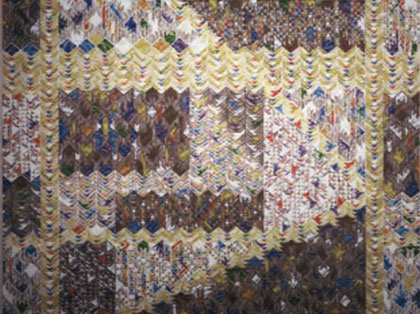Reviews
Critique: Susan Michod's 9/11 Shroud Series
Gozamos, September 2011
Corey Nuffer
Michod's Work Can Be Judged...
Chicago Tribune 1995
Alan Artner
Susan Michod
ARTFORUM, March 1983
Judith Russi Kirshner
Susan Michod
new art examiner, November 1986
Susan Michod
Art News, November 1982
Ronny Cohen
Michod showcases range...
Chicago Sun-Times, Nov. 1986
Sue Taylor
Susan Michod
ARTFORUM 1978
C.L. Morrison
New Dimensions: Surface
August 10-October 7, 1979
Pauline A. Saliga
Susan Michod, Jan Cicero Gallery
Alice Shaddle, Artemesia Gallery
Bill Conger, Zaks Gallery
ARTFORUM, 1978, p. 82
by C.L. Morrison
Alice Shaddle, Artemesia Gallery
Bill Conger, Zaks Gallery
ARTFORUM, 1978, p. 82
by C.L. Morrison

In 1975, Susan Michod’s pattern painting was dense, claustrophobic, and plotted out academically. In tension with the regular repetition of rectangular blocks were exceedingly detailed decorations – polka dots and her ringbone twills. Off the stretcher and pinned directly to the wall, her new work seems freer, more spontaneous and quite poetic. Still relying upon basics of pattern – interchangeable figure-ground relationships and all-over, equal-stress structures – she has now entirely broken away from the previous dense regimentation.
Rather than analyzing flip flops, inversions and permutations on graph paper, Michod now hand sketches various large, flowing, geometric or organic shapes directly onto the blank canvas. She paints in a layer of color and than stamps different motifs potato blocks cut in shapes similar to those of the large painted areas. To the eye, it looks like ducks on a ducklike field, birds on a heartlike field, and so on; the potato blocks become the source of her content or iconography. Sometimes she rotates the stamps, and often she changes the colors and the size of her motifs in relation to the fields. Many “ducks” may fill a “cloverleaf”; a few “cloverleafs” may fill an “arrow”. In the finished paintings, those initial fields may often be discernible as seamless patches, the whole canvas musically changing rhythm or key with few abrupt divisions.
Interestingly enough, many of Michod’s new compositions – unlike much other pattern painting – do not give the effect of being subjects to indefinite extensions. Rather, canvas shape and size do seem to figure in the placement of field and motif. However, a viewer’s eye often becomes so involved with shifts and flows within the integrated structures that canvas edge here seems, rather than any rigid frame, merely a convenient place to stop.
In addition, various changes make this work more personal, despite it’s stamping method, than Michod’s earlier paintings with their conscientious depiction of intimate detail. For one thing, since the color stamped with her potato blocks is neither uniform nor opaque, the results are quite painterly. Wisely she leaves these imprints as they are and does not obliterate them with additional details extraneous to the stamping process. Some of the shapes are white and provide more breathing room; they even can appear as holes in the canvas. Her final decision then to accent or downplay fields with color is made on the basis of her “eye” and intuition. And finally, in personal contrast to her stamping ritual is the playful, childlike quality of the potato-block motifs, which is ultimately, responsible for the work’s success.
Rather than analyzing flip flops, inversions and permutations on graph paper, Michod now hand sketches various large, flowing, geometric or organic shapes directly onto the blank canvas. She paints in a layer of color and than stamps different motifs potato blocks cut in shapes similar to those of the large painted areas. To the eye, it looks like ducks on a ducklike field, birds on a heartlike field, and so on; the potato blocks become the source of her content or iconography. Sometimes she rotates the stamps, and often she changes the colors and the size of her motifs in relation to the fields. Many “ducks” may fill a “cloverleaf”; a few “cloverleafs” may fill an “arrow”. In the finished paintings, those initial fields may often be discernible as seamless patches, the whole canvas musically changing rhythm or key with few abrupt divisions.
Interestingly enough, many of Michod’s new compositions – unlike much other pattern painting – do not give the effect of being subjects to indefinite extensions. Rather, canvas shape and size do seem to figure in the placement of field and motif. However, a viewer’s eye often becomes so involved with shifts and flows within the integrated structures that canvas edge here seems, rather than any rigid frame, merely a convenient place to stop.
In addition, various changes make this work more personal, despite it’s stamping method, than Michod’s earlier paintings with their conscientious depiction of intimate detail. For one thing, since the color stamped with her potato blocks is neither uniform nor opaque, the results are quite painterly. Wisely she leaves these imprints as they are and does not obliterate them with additional details extraneous to the stamping process. Some of the shapes are white and provide more breathing room; they even can appear as holes in the canvas. Her final decision then to accent or downplay fields with color is made on the basis of her “eye” and intuition. And finally, in personal contrast to her stamping ritual is the playful, childlike quality of the potato-block motifs, which is ultimately, responsible for the work’s success.
